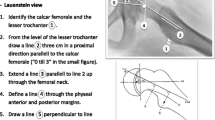Abstract
Background
Slipped capital femoral epiphysis in adults is uncommon. The purpose of this study was to report our own four cases (six hips) of slipped capital femoral epiphysis (SCFE) in adulthood and to review the cases reported in the literature. The authors attempted to investigate the various causative underlying disorders and clinical characteristics, treatment, outcome, and complications.
Methods
We searched for all 22 reported cases of SCFE in adults age 18 years and older via MEDLINE and Google Scholar from 1963 to 2012 without any exception. In doing so, we documented our own four cases, along with seven additional reports that we found in the literature but were not reported by Hu et al. in 2011.
Results
All of 22 cases involved causative pathology: panhypopituitary disorders in 11, hypothyroidism in five, Kallmann syndrome in three, postradiation hypoestrogenism in one, hypogonadotropic hypogonadism as sequel of meningitis in one, and Klinefelter syndrome in one. Eight cases (36 %) involved both hips. The most common treatment modality was internal fixation combined with hormonal replacement therapy. Nineteen hips (63 %) healed well without any complications after fixation of the slipped epiphysis. Avascular necrosis of the femoral head developed in one hip after in situ pin fixation.
Conclusion
Awareness of the variety of conditions under which SCFE can occur is an important factor in early diagnosis, especially in slippage at atypical ages. In the adults with SCFE, it is very important to look for bilateral involvement as this occurs in 36 % of cases.






Similar content being viewed by others
References
Hu MH, Jian YM, Hsueh YT, Lin WH, Yang RS. Slipped capital femoral epiphysis in an adult with panhypopituitarism. Orthopedics. 2011;34:222.
Wells D, King JD, Roe TF, Kaufman FR. Review of slipped capital femoral epiphysis associated with endocrine disease. J Pediatr Orthop. 1993;13:610–4.
Huang KC, Hsu RW. Slipped capital femoral epiphysis in a 23-year-old man – a case report. Acta Orthop. 2007;78:696–7.
Feydy A, Carlier R, Mompoint D, Rougereau G, Patel A, Vallee C. Bilateral slipped capital femoral epiphysis occuring in an adult with acromegalic gigantism. Skeletal Radiol. 1997;26:188–90.
McAfee PC, Cady RB. Endocrinologic and metabolic factors in atypical presentations of slipped capital femoral epiphysis: Report of four cases and review of the literature. Clin Orthop Relat Res. 1983;180:188–97.
Nourbakhsh A, Ahmed HA, McAuliffe TB, Garges KJ. Case report: bilateral slipped capital femoral epiphyses and hormone replacement. Clin Orthop Relat Res. 2008;466:743–8.
Hennessy MJ, Jones KL. Slipped capital femoral epiphysis in a hypothyroid adult male. Clin Orthop Relat Res. 1982;165:204–8.
Al-Aswad BI, Weinger JM, Schneider AB. Slipped capital femoral epiphysis in a 35-year-old man (a case report). Clin Orthop Relat Res. 1978;134:131–4.
Epps CH Jr, Martin ED. Slipped capital femoral epiphysis in a sexually mature myxedematous female. JAMA: J Am Med Assoc. 1963;183:287–9.
Primiano GA, Hughston JC. Slipped capital femoral epiphysis in a true hypogonadal male (Klinefelter’s mosaic XY-XXY). A case report. J Bone Joint Surg Am. 1971;53:597–601.
Heatley F, Greenwood R, Boasem D. Slipping of the upper femoral epiphyses in patients with intercranial tumours causing hypopituitarism and chiasmal compression. J Bone Joint Surg Br. 1976;58:169–75.
Koteles MR Jr, Lewi JE. Visual vignette. Slipped capital femoral epiphysis (SCFE) attributable to primary hypothyroidism. Endocr Pract. 2010;16:340.
Brady RL, Price A. Delayed-onset slipped capital femoral epiphysis: case report of association with pituitary tumor. Am J of Orthop (Belle Mead, NJ). 2010;39:137.
Kim K, Kim S, Park C, Ahn K. A case report of slipped capital femoral epiphysis associated with Hypogonadism and Diabetes insipidus. J Korean Orthop Assoc. 1988;23:911–6.
Choy W, Kim H, Lee K, Park K. Kallmann’ syndrome assciated with slipped capital femoral epiphysis—one case report—. J Korean Orthop Assoc. 1991;26:1937–43.
Takahashi MP, Miyai I, Matsumura T, Nozaki S, Kang J. A case of Kallmann syndrome with empty sella and arachnoid cyst. Rinsho Shinkeigaku. 1997;37:704–7.
Causey AL, Smith ER, Donaldson JJ, Kendig RJ, Fisher LC 3rd. Missed slipped capital femoral epiphysis: illustrative cases and a review. J Emerg Med. 1995;13:175–89.
Song KS, Oh CW, Lee HJ, Kim SD. Epidemiology and demographics of slipped capital femoral epiphysis in Korea: a multicenter study by the Korean Pediatric Orthopedic Society. J Pediatr Orthop. 2009;29:683–6.
Bhatia NN, Pirpiris M, Otsuka NY. Body mass index in patients with slipped capital femoral epiphysis. J Pediatr Orthop. 2006;26:197–9.
Pritchett JW, Perdue KD. Mechanical factors in slipped capital femoral epiphysis. J Pediatr Orthop. 1988;8:385–8.
Loder RT, Wittenberg B, DeSilva G. Slipped capital femoral epiphysis associated with endocrine disorders. J Pediatr Orthop. 1995;15:349–56.
Meuric S, Brauner R, Trivin C, Souberbielle JC, Zerah M, Sainte-Rose C. Influence of tumor location on the presentation and evolution of craniopharyngiomas. J Neurosurg. 2005;103:421–6.
Loder RT, O’Donnell PW, Didelot WP, Kayes KJ. Valgus slipped capital femoral epiphysis. J Pediatr Orthop. 2006;26:594–600.
Acknowledgments
Medical editor Katharine O’Moore-Klopf, ELS (East Setauket, NY, USA) provided professional English-language editing of this article.
Conflict of interest
The authors declare that they have no conflict of interest.
Author information
Authors and Affiliations
Corresponding author
Additional information
The authors did not receive grants or outside funding in support of their research or preparation of this manuscript.
About this article
Cite this article
Song, K.S., Lim, Y.W., Ok, I.Y. et al. Delayed-onset of slipped capital femoral epiphysis. J Orthop Sci 20, 78–86 (2015). https://doi.org/10.1007/s00776-014-0660-x
Received:
Accepted:
Published:
Issue Date:
DOI: https://doi.org/10.1007/s00776-014-0660-x




